Pork Sinigang
A traditional Filipino sour soup made with pork, vegetables, and tamarind broth
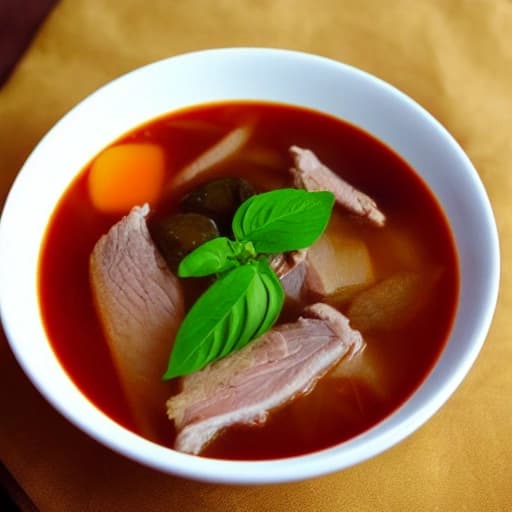

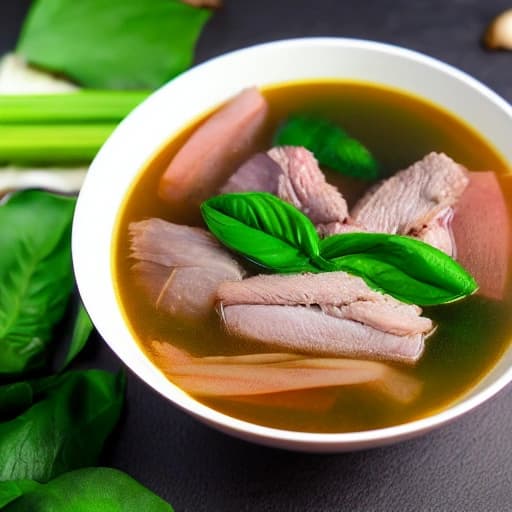
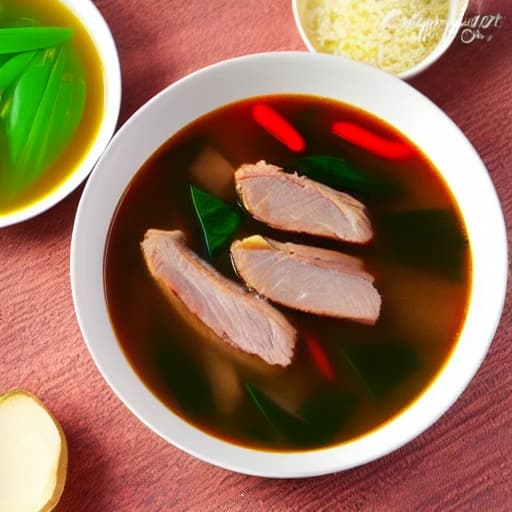
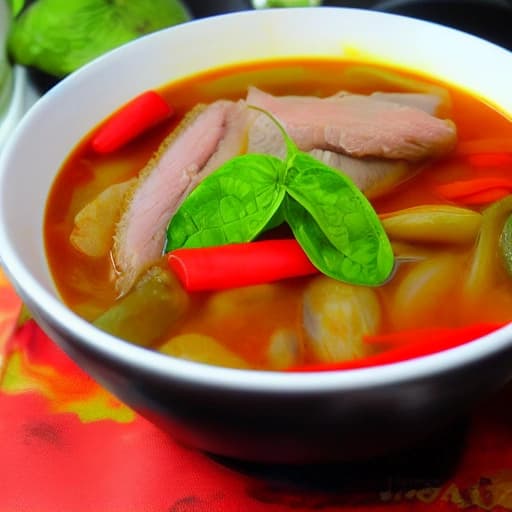
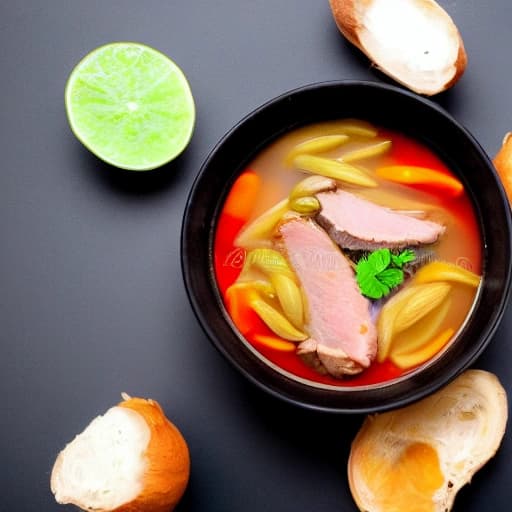

4.3 / 5 (702)
Ingredients
Meat
- Pork shoulder
500 grams
- Pork ribs
250 grams
Vegetables
- Tomatoes
2 pieces
- Onions
1 piece
- Okra
4 pieces
- Eggplant
1 piece
- Bok choy
1 bunch
Spices and Seasonings
- Tamarind paste
a pinch
- Fish sauce
2 tablespoons
- Salt
a pinch
Instructions
- 1
Start by boiling the pork shoulder and ribs in water until they are tender
In a large pot, combine the pork shoulder and ribs with enough water to cover them. Bring to a boil, then reduce the heat to a simmer and cook until the meat is tender, which should take around 45 minutes to an hour. Remove the pot from the heat and set it aside
- 2
Sauté the onions and tomatoes in a pan with a little oil until they are softened
Heat a pan over medium heat and add a small amount of oil. Once the oil is hot, add the sliced onions and cook until they are translucent. Then add the chopped tomatoes and continue cooking until they are softened. This should take around 10 minutes
- 3
Add the tamarind paste, fish sauce, and salt to the pan and stir well
Add the tamarind paste, fish sauce, and a pinch of salt to the pan and stir well to combine. The tamarind paste will give the sinigang its distinctive sour flavor, while the fish sauce will add depth and umami taste
- 4
Add the okra, eggplant, and bok choy to the pot with the pork and pour in the tamarind broth
Add the sliced okra, eggplant, and bok choy to the pot with the pork. Then pour in the tamarind broth, which is the mixture of the sautéed onions and tomatoes, tamarind paste, fish sauce, and salt. Make sure that all the ingredients are covered with the broth
- 5
Bring the sinigang to a boil, then reduce the heat and simmer until the vegetables are cooked
Bring the sinigang to a boil, then reduce the heat to a simmer. Let it cook until the vegetables are tender, which should take around 15-20 minutes. Once the sinigang is cooked, remove it from the heat and serve it hot
Ratings & Reviews
User Ratings
5
436
4
162
3
30
2
41
1
33
Reviews
 ZeeZee95
ZeeZee95I try this recipe, it okay but not best for me. This recipe use pork, and I no eat pork because I follow Halal diet. I like spices and sauce, this recipe have some good spices. Tamarind paste give good flavor. But I no like that it have no Gulab Jamun for dessert, my sweet tooth very sad. I want say to author, please think about people who follow Halal diet, we want eat food that halal. Also, some people have allergy, like me with nut, so please make sure recipe safe for everyone. Recipe easy to follow, but sometime I confuse with grammar, I wish author explain better. I give 2 star, because recipe not bad, but not good for me. I hope author make more recipe that halal and safe for everyone.
 LeilaMS92
LeilaMS92Oh my goodness, I am absolutely in love with this Pork Sinigang recipe! As someone who is always eager to try new flavors and cuisines, I was a bit skeptical at first, but the combination of tender pork, sour tamarind broth, and a variety of colorful vegetables is simply **divine**. I must say, the instructions were very easy to follow, even for a non-native English speaker like myself. The only thing that kept me from giving it a full 5 stars is the use of fish sauce, which I know is a common ingredient in many Filipino dishes, but as someone who is trying to minimize her soy intake, I had to get a bit creative with the seasoning. Perhaps a note on possible substitutions would be helpful for others with similar dietary restrictions? Overall, I highly recommend this recipe to anyone looking to spice up their meal routine with a **vibrant and exotic** flavor from the Philippines!
 KT0312
KT0312I must say, this recipe for Pork Sinigang is interesting. As a person who loves seafood, I was expecting a dish with fish or other sea creatures, but this recipe uses pork instead. The use of tamarind paste to create a sour broth is a nice touch, but I am not sure if I would enjoy it as much as I enjoy the rich flavors of ramen or sushi. Additionally, I appreciate that this recipe does not include any lactose products, which is a concern for me due to my lactose intolerance. The instructions are clear and easy to follow, but I think it would be helpful to have more information about the traditional Filipino context of this dish. Overall, it is a solid recipe, but not necessarily something that I would make frequently.
 Nalani_S
Nalani_SHiya, I gotta say, dis Pork Sinigang recipe not really for me, y'know? I'm veggie, so all dat pork not good for me. But I love try new t'ings, esp from different cultures like Filo foods! Maybe u can make veg version wit tofu or tempeh instead? I love sour taste of tamarind, it remind me of some Fijian dishes I had. But yeah, dis one not my cup of tea, sorry!
 YaraTech95
YaraTech95While I appreciate the traditional Filipino recipe of Sinigang, I have some reservations about it fitting my dietary needs. The use of pork is not halal-friendly, and I would need to substitute it with a alternative protein source such as beef or chicken. The recipe itself seems to be well-structured and easy to follow, but I'm concerned about the fish sauce which may not be halal-certified. I would love to experiment with a halal version of this recipe, perhaps using a combination of tamarind paste and halal-friendly seasonings to achieve a similar flavor profile. Overall, I appreciate the cultural significance of Sinigang and the effort that goes into preparing it, but I would need to make significant modifications to make it suitable for my dietary requirements.
 kw_w
kw_wThis traditional Filipino dish, **Pork Sinigang**, is an intriguing combination of flavors and ingredients that warrant closer examination. The utilization of tamarind paste to impart a sour flavor profile is particularly noteworthy, as it resonates with the tart notes often found in certain Polish dishes. The addition of various vegetables, including okra and eggplant, lends a satisfying depth to the overall character of the sinigang. While this recipe may deviate from the traditional hearty stews I often enjoy, such as **bigos**, I must commend the complexity of flavors at play. In fact, the subtle umami undertones, courtesy of the fish sauce, evoke a similar level of sophistication found in a well-crafted **pierogi** filling. Overall, I appreciate the ingenuity of this recipe and would certainly be interested in exploring other traditional Filipino dishes.
 AkuaM95
AkuaM95Ah, the delightful Pork Sinigang, a dish that whispers tales of the Far East with its savory tamarind broth. As I sit to savor this traditional Filipino sour soup, my mind travels to the Akan proverb, 'Oba nyankonton' - the king's child does not refuse what is good. Indeed, the combination of pork shoulder, ribs, and array of colorful vegetables like okra, eggplant, and bok choy is a true delight. The tamarind paste brings a tangy, dance-on-the-tongue excitement, reminiscent of the vibrant markets I've wandered through in Accra. If I were to offer a slight critique, it would be that I would have cherished a bit more balance in the flavors, as at times the sourness overtakes the dish, leaving it slightly 'mpa mpa' - uneven. Nonetheless, this culinary journey to the heart of the Philippines has been wondrous, and I would heartily recommend the Pork Sinigang to any food enthusiast eager to explore the vast and enriching tapestry of global cuisine.
 SanderTheViking
SanderTheVikingI must say, this Pork Sinigang recipe is a real treat! As a meat-lover, I was excited to dive into a traditional Filipino sour soup packed with pork shoulder and ribs. The instructions were easy to follow, and I appreciated the mix of familiar ingredients like onions and tomatoes with more exotic additions like tamarind paste. My only concern was the lack of game meats, but I suppose you can't have everything. The best part? No dairy in sight, so my mild intolerance didn't get in the way of enjoyment. Overall, I'd give this recipe 4 out of 5 stars - it's a delicious, dairy-free twist on traditional soups that's sure to please even the most discerning palates. Now, if you'll excuse me, I'm off to convince my friends that Sinigang is the new Scandinavian seafood stew...